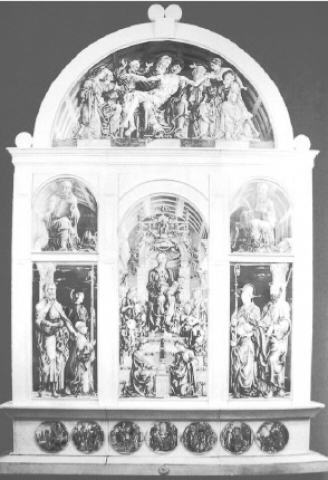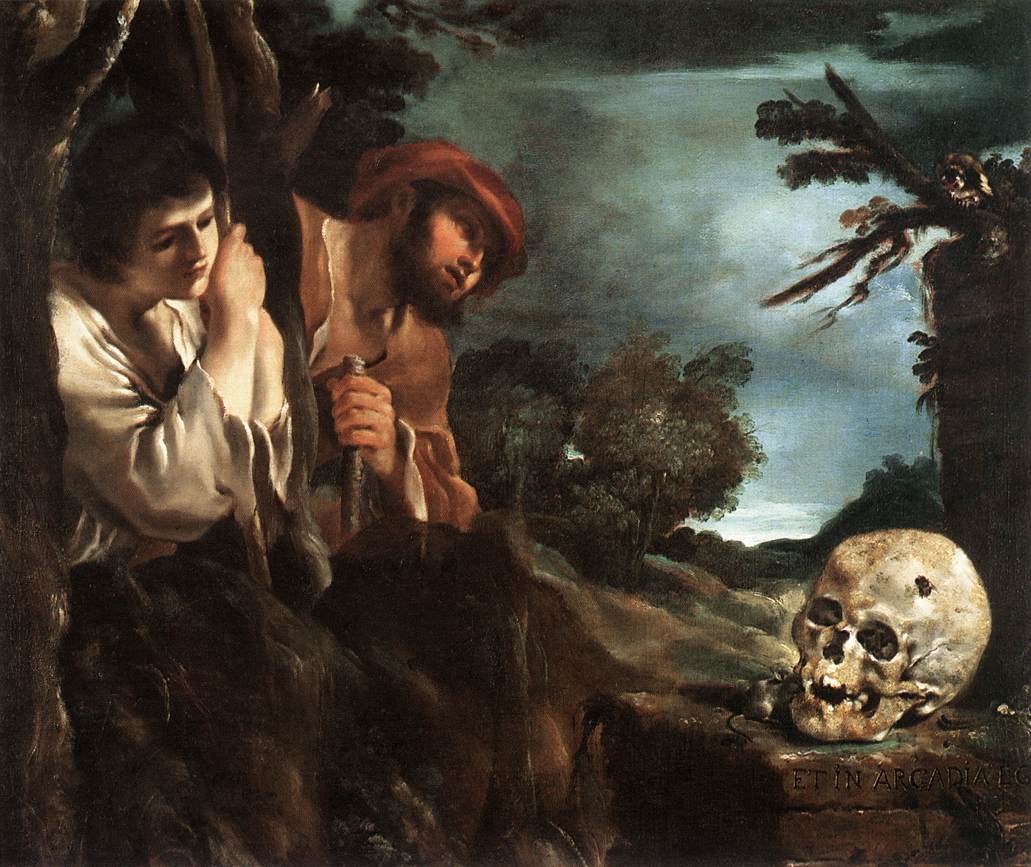|
Saint Maurelius Altarpiece
The Saint Maurelius Altarpiece was an oil on panel painting by Cosmè Tura, executed ''c.'' 1480, produced for the church of San Giorgio fuori le mura, site of Maurelius of Voghenza's shrine. Two tondos from it survive, ''Trial of St Maurelius'' and ''Martyrdom of St Maurelius'', both now in the city's Pinacoteca Nazionale. It was commissioned in the 1470s during a rebuilding of the church prior to its reconsecration. The work's original structure is unknown, but probably had a now-lost central panel of Maurelius himself with a number of panels (perhaps six) with episodes from his life, the only two survivors of which are the Pinacoteca panels. The two panels are the right shape perhaps to have formed part of a predella, though they are larger than the usual size for such panels - the tondi of the Roverella Altarpiece by the same artist are 38 cm in diameter. The altarpiece fell into disrepair and in 1635 was replaced by one on the same subject by Guercino. The two tondo ... [...More Info...] [...Related Items...] OR: [Wikipedia] [Google] [Baidu] |
Cosmè Tura
Cosmê Tura (c. 1430 – 1495), also known as Il Cosmè or Cosimo Tura (), was an Italian early- Renaissance (or Quattrocento) painter and considered one of the founders of the School of Ferrara. Biography Formation The painter's origins are humble: he was born in Ferrara, the son of a shoemaker named Domenico. There is no news on his apprenticeship, which Vasari linked to the mysterious artist Galasso Ferrarese, an almost mythical figure, linked by friendship to Piero della Francesca. The first documents concerning him are dated to the two-year period 1451–1452, when he decorated some objects for the Este court, such as some flags with Este coats of arms for the Castle or a helmet given as a prize to the winner of a tournament. These works were the order of the day in the artistic workshops and represented for them one of the major sources of livelihood. Perhaps he was able to work among the court illuminators. From mid-1452 to April 1456 there are no other documents in ... [...More Info...] [...Related Items...] OR: [Wikipedia] [Google] [Baidu] |
Basilica Of San Giorgio Fuori Le Mura
Saint George's Basilica is a Roman Catholic church in Ferrara, Italy. It is called in Italian, meaning Saint George's "outside the walls" because it was built outside the city walls, while Saint George's Cathedral was within the city walls. It is the oldest church in the city. History The history of the Basilica is closely linked with the origins of Ferrara. Between the seventh and eighth centuries, due to continual barbarian invasion that devastated Voghiera, the bishopric was moved from Voghiera and the location near the Po river became the first settlement for the town of Ferrara. Soon the town of Ferrara grew larger on the other bank of the Po river and in 1135 the bishop's seat was moved to the Cathedral of Ferrara in the center of the city. The Basilica was completely rebuilt in the fifteenth century by Biagio Rossetti Biagio Rossetti ( 1447 – 1516) was an Italian architect and urbanist from Ferrara. A military engineer since 1483, and the ducal architect of Ercole I ... [...More Info...] [...Related Items...] OR: [Wikipedia] [Google] [Baidu] |
Maurelius Of Voghenza
Maurelius of Voghenza (Italian - ''San Maurelio''; died 7 May 644) was a Syrian priest, who became bishop of Voghenza. He is venerated as a saint by the Roman Catholic Church. Life Little information survives on his life, though a Latin account of it was written in 1489, ''Legendary and Life and Miracles of Saint Maurelius''. This stated that Maurelius was born in Edesa as one of the sons of Theobald, the pagan king of Mesopotamia. Two more sons were born to his father when Maurelius was aged 18, named Hippolytus and Rivallus. When Maurelius reached the age of 30 he revealed to his father that he had converted to Christianity but his father refused permission for him to continue living as a Christian. He succeeded his father on his death, but passed the throne to Hippolytus soon afterwards to follow his faith more closely, beginning spiritual instruction under Theophilus of Antioch, bishop of Smirne, who finally ordained him a priest. Theophilus then authorised him to examine ... [...More Info...] [...Related Items...] OR: [Wikipedia] [Google] [Baidu] |
Tondo (art)
A tondo (plural "tondi" or "tondos") is a Renaissance term for a circular work of art, either a painting or a sculpture. The word derives from the Italian ''rotondo,'' "round." The term is usually not used in English for small round paintings, but only those over about 60 cm (two feet) in diameter, thus excluding many round portrait miniatures – for sculpture the threshold is rather lower. A circular or oval relief sculpture is also called a roundel. History Artists have created tondi since Greek antiquity. The circular paintings in the centre of painted vases of that period are known as tondi, and the inside of the broad low winecup called a '' kylix'' also lent itself to circular enframed compositions. The style was revived in the fifteenth and sixteenth centuries, particularly in Italy, where it may have developed from the smaller desco da parto or birthing tray. Since then it has been less common. In Ford Madox Brown's painting '' The Last of England'', the ... [...More Info...] [...Related Items...] OR: [Wikipedia] [Google] [Baidu] |
Pinacoteca Nazionale (Ferrara)
The Pinacotecta Nazionale () is an art gallery in Ferrara, Emilia-Romagna, Italy. It is located on the ''piano nobile'' (or first floor) of the Palazzo dei Diamanti, a work of Renaissance architecture by Biagio Rossetti, commissioned by Leonello d’Este in 1447. Not to be confused with the Civic Museum on the lower floor, which has hosted temporary exhibitions of contemporary art since 1992, the Pinacoteca houses a collection of paintings by the Ferrarese School dating from the thirteenth to the eighteenth centuries. It was founded in 1836 by the Municipality of Ferrara after Napoleon's widespread dissolution of churches threatened the protection of important public artworks. The gallery is formed as much around notable northern Italian painters as it is around the exquisite interior decoration of the palace itself, together with remnants of frescoes from local churches and later acquisitions from the Sacrati Strozzi collection. Since 2015 the Pinacoteca Nazionale has formed a p ... [...More Info...] [...Related Items...] OR: [Wikipedia] [Google] [Baidu] |
Predella
In art a predella (plural predelle) is the lowest part of an altarpiece, sometimes forming a platform or step, and the painting or sculpture along it, at the bottom of an altarpiece, sometimes with a single much larger main scene above, but often (especially in earlier examples), a polyptych or multipanel altarpiece. In late medieval and Renaissance altarpieces, where the main panel consisted of a scene with large figures, it was normal to include a predella below with a number of small-scale narrative paintings depicting events from the life of the dedicatee, whether the ''Life of Christ'', the ''Life of the Virgin'' or a saint. Typically there would be three to five small scenes, in a horizontal format. Sometimes a single space shows different scenes in continuous representation. They are significant in art history, as the artist had more freedom from iconographic conventions than in the main panel as they could only be seen from close up. As the main panels themselves ... [...More Info...] [...Related Items...] OR: [Wikipedia] [Google] [Baidu] |
Roverella Altarpiece
The Roverella Altarpiece was a religious painting by Cosmè Tura completed during 1470–1474 using oil and egg-tempera on poplar panel work, commissioned by abbot and cardinal Bartolomeo Roverella for San Giorgio fuori le mura in Ferrara in memory of his brother bishop Lorenzo Roverella. It was one of the most significant works of the artist and of the Ferrara Renaissance in general. It was damaged in an explosion in 1709 and moved out of the church. It is now dismembered and their panels split up between several museums. Description An 18th century description of the altarpiece was made by Girolamo Baruffaldi. Based on that information Maurizio Bonora created a reconstruction with the technique of graphite on paper. The altarpiece was composed of six main panels, with a large ''Madonna and Child Enthroned'' in the center and on the sides two lower panels, with saints and characters of the Roverella family, surmounted by a panel with a kneeling saint each. Above was the large lu ... [...More Info...] [...Related Items...] OR: [Wikipedia] [Google] [Baidu] |
Guercino
Giovanni Francesco Barbieri (February 8, 1591 – December 22, 1666),Miller, 1964 better known as Guercino, or il Guercino , was an Italian Baroque painter and draftsman from Cento in the Emilia region, who was active in Rome and Bologna. The vigorous naturalism of his early manner contrasts with the classical equilibrium of his later works. His many drawings are noted for their luminosity and lively style. Biography Giovanni Francesco Barbieri was born into a family of peasant farmers in Cento, a town in the Po Valley mid-way between Bologna and Ferrara.Mahon, 1937a Being cross-eyed, at an early age he acquired the nickname by which he is universally known, Guercino (a diminutive of the Italian noun '' guercio'', meaning 'squinter').Turner, 2003 Mainly self-taught, at the age of 16, he worked as apprentice in the shop of Benedetto Gennari, a painter of the Bolognese School. An early commission was for the decoration with frescos (1615–1616) of Casa Pannini in Cento, ... [...More Info...] [...Related Items...] OR: [Wikipedia] [Google] [Baidu] |
Sacristy
A sacristy, also known as a vestry or preparation room, is a room in Christian churches for the keeping of vestments (such as the alb and chasuble) and other church furnishings, sacred vessels, and parish records. The sacristy is usually located inside the church, but in some cases it is an annex or separate building (as in some monasteries). In most older churches, a sacristy is near a side altar, or more usually behind or on a side of the main altar. In newer churches the sacristy is often in another location, such as near the entrances to the church. Some churches have more than one sacristy, each of which will have a specific function. Often additional sacristies are used for maintaining the church and its items, such as candles and other materials. Description The sacristy is also where the priest and attendants vest and prepare before the service. They will return there at the end of the service to remove their vestments and put away any of the vessels used duri ... [...More Info...] [...Related Items...] OR: [Wikipedia] [Google] [Baidu] |
Paintings By Cosmè Tura
Painting is the practice of applying paint, pigment, color or other medium to a solid surface (called the "matrix" or "support"). The medium is commonly applied to the base with a brush, but other implements, such as knives, sponges, and airbrushes, can be used. In art, the term ''painting ''describes both the act and the result of the action (the final work is called "a painting"). The support for paintings includes such surfaces as walls, paper, canvas, wood, glass, lacquer, pottery, leaf, copper and concrete, and the painting may incorporate multiple other materials, including sand, clay, paper, plaster, gold leaf, and even whole objects. Painting is an important form in the visual arts, bringing in elements such as drawing, composition, gesture (as in gestural painting), narration (as in narrative art), and abstraction (as in abstract art). Paintings can be naturalistic and representational (as in still life and landscape painting), photographic, abstract, narrative, s ... [...More Info...] [...Related Items...] OR: [Wikipedia] [Google] [Baidu] |






